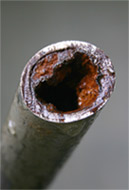
- The TRUTH About America's Water
- Water Pollutants that Cause Illness
- Are Minerals in Water Important for Health?
- Top 5 Drinking Water Contaminants
- Do I Need a Whole House Water Filter?
The Basic Type of Corrosion Explained - Page 2
In many home water systems galvanized pipe is used in conjunction with brass valves or other fittings. At every joint between the dissimilar metals, an electric current is generated, and this causes corrosion of one of the metals. The rate at which this reaction occurs is largely determined by the conductivity of the water and the amount of brass in relation to zinc. In turn, this conductivity is determined by the amounts of various minerals in the water. Fortunately, most water supplies have low conductivity. Thus, the corrosion which occurs does not cause major problems. However, with other water supplies, this type of corrosion increases the amount of iron in the water and leads to premature failure of pipelines and water heaters. Galvanic corrosion produces pitting or deep etching in the less noble* of the two metals.

Further, this type of corrosion occurs close to the point where the less noble connects with the more noble metal. It would seem that the use of a single metal throughout a plumbing system might prevent this type of corrosion.
While this practice does help, it will not guarantee the prevention of corrosion. Why? Because local impurities may exist on the metallic surface. There may be impurities in the zinc used to galvanize steel pipes. Again there may be impurities due to either the metallic or the nonmetallic substances in the water itself. In any event, there is always the possibility of corrosion. The rate of corrosion due to electrolytic action depends on the dissolved mineral solids in the water. The more of these solids, the greater their ability to carry an electric current. Hence the greater its corrosiveness.
The Free Oxygen
Free oxygen in water can also cause corrosion. Just as metals are exposed to air rust or tarnish, metals in the plumbing system can be attacked by the oxygen in the water. The oxygen in water actually combines with the metal to form an "oxide." The chemical reaction is the same as occurs when moist air rusts unprotected metallic surfaces. In water or in moist air, a reaction with oxygen consumes a portion of the metal present. Corrosion in water systems due to dissolved oxygen commonly takes the form of deep pitting rather than a general attack of the entire surface. The end result may not look as bad as when the entire surface is attacked. But a single small hole can make a component of a plumbing system useless.
Temperature increases affect the rate of corrosion because an increase in temperature increases the rate of the electrochemical corrosion reaction. As a rule, an increase in temperature results in a stepping up of the corrosive action of the water. In household water supplies the use of greater volumes of hot water has intensified the corrosive action of water. Even where there is little or no corrosion in the cold water lines of a home, a high corrosion rate may exist in the hot water system. Certainly, corrosion is far more probable in the hot water lines than in the cold in almost any household installation. Studies show that the corrosion of steel may be stepped up three to four times the normal rate when the temperature of the water is increased from 60°F to 140°F. Over 140°F the rate may double with every 20-degree increase in temperature.
Due to the possible interplay of the three major causes of corrosion, it is not always simple to pinpoint the source of corrosion trouble in any given instance. Yet you need to have some idea of what's causing the trouble in order to correct a corrosion problem.





